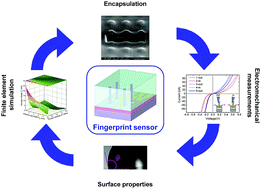Design of UV-crosslinked polymeric thin layers for encapsulation of piezoelectric ZnO nanowires for pressure-based fingerprint sensors†
Abstract
The demand for biometric identification, and more particularly fingerprint recognition, has significantly increased in recent years in domains such as national security, controlled access to health care, banking and leisure. Typical resolution of current fingerprint sensors constitutes 500 dpi, which conforms to the FBI standard for the detection of level 1 (pattern) and level 2 (minutiae) features. However, at least 1000 dpi is required to extract the tiniest level 3 features such as shape of pores and ridge edges. To address an increasing need for the highest reliability in fingerprint identification, this work presents the elaboration of a specific encapsulation polymeric layer for a new design of a pressure sensor which is expected to provide higher resolution and minimal volume occupation compared to already existing setups. The sensor comprises a periodic array of individually contacted piezoelectric ZnO nanowires (NWs), which generate piezopotentials when deformed (each electrically addressable NW constitutes a pressure-sensitive pixel). Fragile NWs cannot undergo direct contact with the finger, therefore a polymeric encapsulation layer is required to simultaneously provide physical protection and to transfer the force from the finger to the NWs. To ensure sensor robustness, the polymeric layer must also exhibit appropriate chemical inertness, and water- and oil-repellency. To achieve this aim, novel formulations of UV-crosslinkable polymeric materials were developed, prepared and deposited as thin layers on the NWs using spin-coating by following the recommendations derived from numerical simulations. An ideal balance between polymer formulation processability and final thin layer's characteristics (Young's modulus, thickness) was identified. The resulting encapsulation layer was proved to properly protect the piezoelectric ZnO nanowires from breaking under pressure forces and from being contaminated with external impurities while enabling successful collection of electrical signals in a bottom–bottom contacted NW configuration.



 Please wait while we load your content...
Please wait while we load your content...